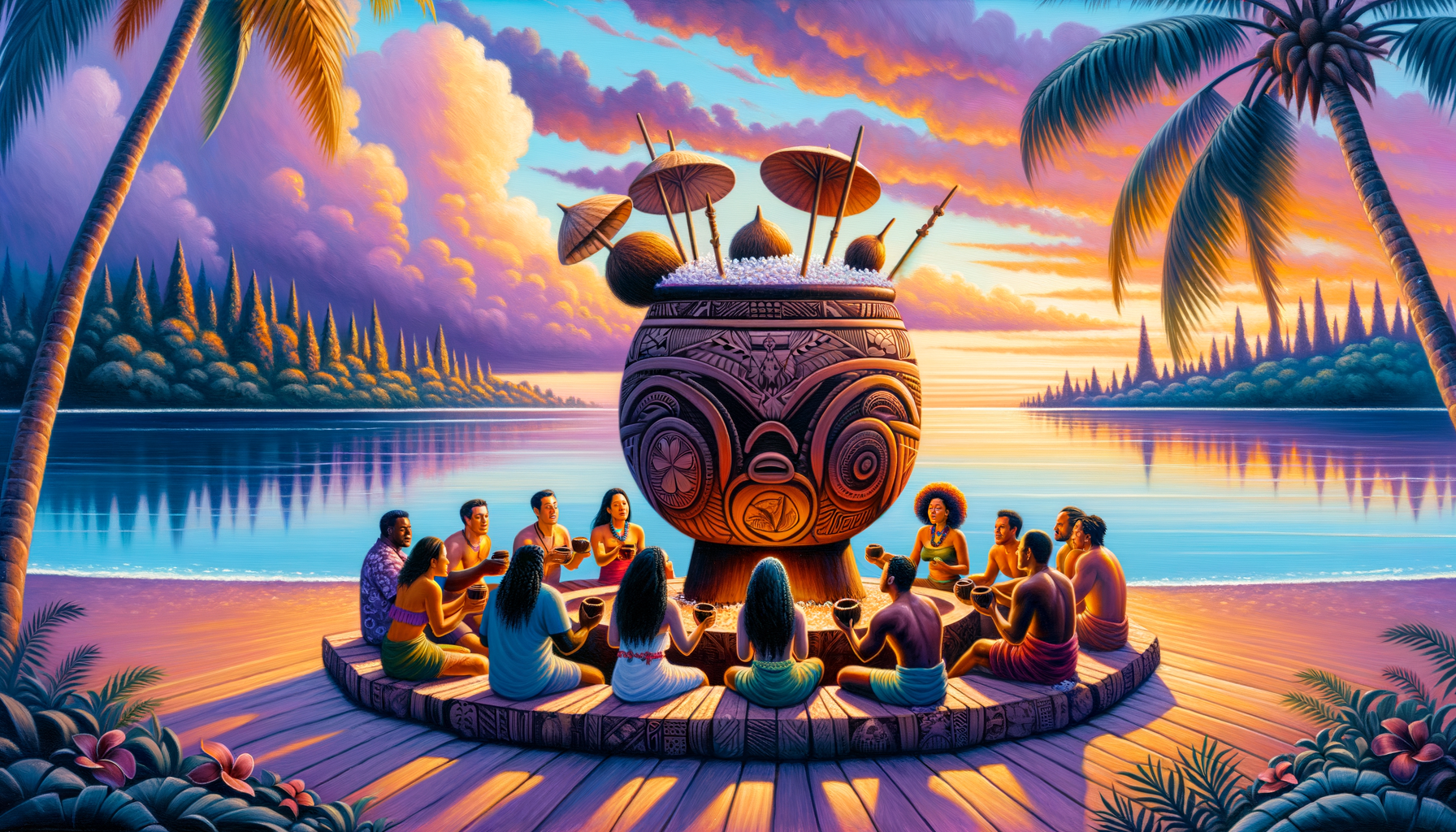Imagine sitting with friends around a beautifully made bowl, sharing stories, and drinking a soothing drink that has brought people together for many years. Welcome to the world of the kava tanoa.
The kava tanoa is a special bowl used in kava rituals and ceremonies. I first saw a tanoa in Fiji on a calm beach as the sun set over the Pacific. The locals invited me to join their kava circle, and at the center was a stunning kava tanoa, carved from a single piece of wood. When I took my first sip of kava, I felt connected not just to the people there but to a tradition handed down through generations.
What is a Kava Tanoa?
A kava tanoa is more than just a bowl; it stands for unity, tradition, and craftsmanship. This bowl, often made from special hardwoods found in the Pacific Islands, is used to prepare and drink kava. Imagine a big, round bowl with a wide brim, resting on many short legs—each leg symbolizing the foundation of the community. Intricate carvings make the kava tanoa not just functional but also a piece of art.
The kava tanoa has been an essential part of kava ceremonies in places like Fiji, Tonga, and Samoa. These ceremonies are not just social events; they are rituals filled with respect and tradition. The kava tanoa is the centerpiece where the kava is mixed and served, often with chants, claps, and a strong sense of community.
Craftsmanship and Design of the Kava Tanoa
Making a kava tanoa is an art passed down through families. Craftsmen use hardwoods like vesi or ifilele, which are durable and give the bowl a deep, rich color. The process begins with choosing the right piece of wood, free from cracks. Using traditional tools, the artisan carefully carves the kava tanoa, making sure it stays beautiful and useful.
Common designs include carvings of marine life, geometric shapes, and spiritual symbols, each telling a story. These elements are not just for decoration; they represent the culture, spirituality, and values of the community. The legs of the kava tanoa symbolize the strength and unity of the community.
The Role of the Kava Tanoa in Ceremonies
In kava ceremonies, the kava tanoa is the heart of the gathering. The ceremony often starts with mixing the kava, a task requiring skill and respect. The person responsible—usually an elder or a respected person—kneels beside the tanoa, mixing the kava with great care.
Once prepared, the kava is poured into smaller cups, often made from coconut shells, and shared among the participants. This ritual fosters a sense of bonding and community. Drinking kava from a kava tanoa feels like joining a sacred pact of unity.
Respect and tradition are very important in these ceremonies. The kava tanoa is treated with reverence, cleaned thoroughly, and kept in a special place. It symbolizes cultural heritage and solidarity.
Modern Adaptations and Uses of the Kava Tanoa
As kava becomes popular outside the Pacific Islands, the traditional kava tanoa is being used in new ways. Modern kava drinkers are blending old designs with contemporary looks. In urban kava bars, you can find both traditional and modern kava tanoa, serving as focal points for kava circles.
I remember one evening at a kava bar in New York City where a modern kava tanoa, made with traditional hardwood and sleek metal accents, caught everyone’s attention. We sat around it, sipping kava, sharing stories, and making new memories—showing that while the setting may change, the spirit of the kava tanoa lives on.
How to Choose and Care for Your Kava Tanoa
When picking a kava tanoa, consider a few key factors. The size is important; a larger tanoa is great for bigger groups, while a smaller one suits more intimate gatherings. The material matters, too; traditional hardwoods are durable and beautiful, but modern materials can work well too.
To care for your kava tanoa, rinse it with warm water and a soft cloth after each use. Avoid harsh chemicals that could damage the wood. If your tanoa is carved, use a soft brush to clean the details gently.
For a high-quality kava tanoa, look for stores or online shops that specialize in Pacific Islander crafts to ensure it is authentic and responsibly made.
The Future of the Kava Tanoa
The tradition of the kava tanoa faces challenges in a fast-changing world, but efforts are underway to preserve this cultural heritage. Communities and artisans are working together to keep the craftsmanship and traditional practices alive.
Innovation is also playing a role. New trends are emerging, like eco-friendly materials and customizable designs, making the kava tanoa accessible to more people while respecting its roots.
The kava tanoa is not just a piece of the past; it’s a lively part of today’s culture that brings people together. By taking part in kava ceremonies and sharing stories around the tanoa, we can keep this tradition alive for the future.
Recap of the Kava Tanoa
The kava tanoa is a marvel of craftsmanship and a cornerstone of cultural tradition. From its intricate design to its central role in kava ceremonies, the kava tanoa symbolizes unity, respect, and community.
So, next time you have the chance, try experiencing kava from a kava tanoa. Whether you are in a traditional setting or a modern kava bar, you’ll feel a sense of connection that goes beyond time and place. The kava tanoa has the power to bring people together, creating bonds that last a lifetime.
Keywords to include: kava tanoa, kava ceremonies, kava rituals, Pacific Island traditions, handcrafted kava bowl.

Leave a Reply